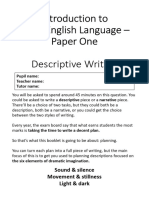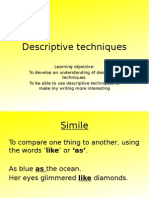0% found this document useful (0 votes)
5 views2 pagesDescriptive Writing
The document provides guidelines for descriptive writing, emphasizing the importance of showing rather than telling through sensory details and vivid imagery. It outlines the use of the five senses, the creation of mood, the incorporation of figurative language, and the necessity for specific vocabulary and varied sentence structures. Additionally, it advises writers to stay focused on the setting and to organize their descriptions logically.
Uploaded by
Hanw HaroonCopyright
© © All Rights Reserved
We take content rights seriously. If you suspect this is your content, claim it here.
Available Formats
Download as PDF, TXT or read online on Scribd
0% found this document useful (0 votes)
5 views2 pagesDescriptive Writing
The document provides guidelines for descriptive writing, emphasizing the importance of showing rather than telling through sensory details and vivid imagery. It outlines the use of the five senses, the creation of mood, the incorporation of figurative language, and the necessity for specific vocabulary and varied sentence structures. Additionally, it advises writers to stay focused on the setting and to organize their descriptions logically.
Uploaded by
Hanw HaroonCopyright
© © All Rights Reserved
We take content rights seriously. If you suspect this is your content, claim it here.
Available Formats
Download as PDF, TXT or read online on Scribd
/ 2























































































